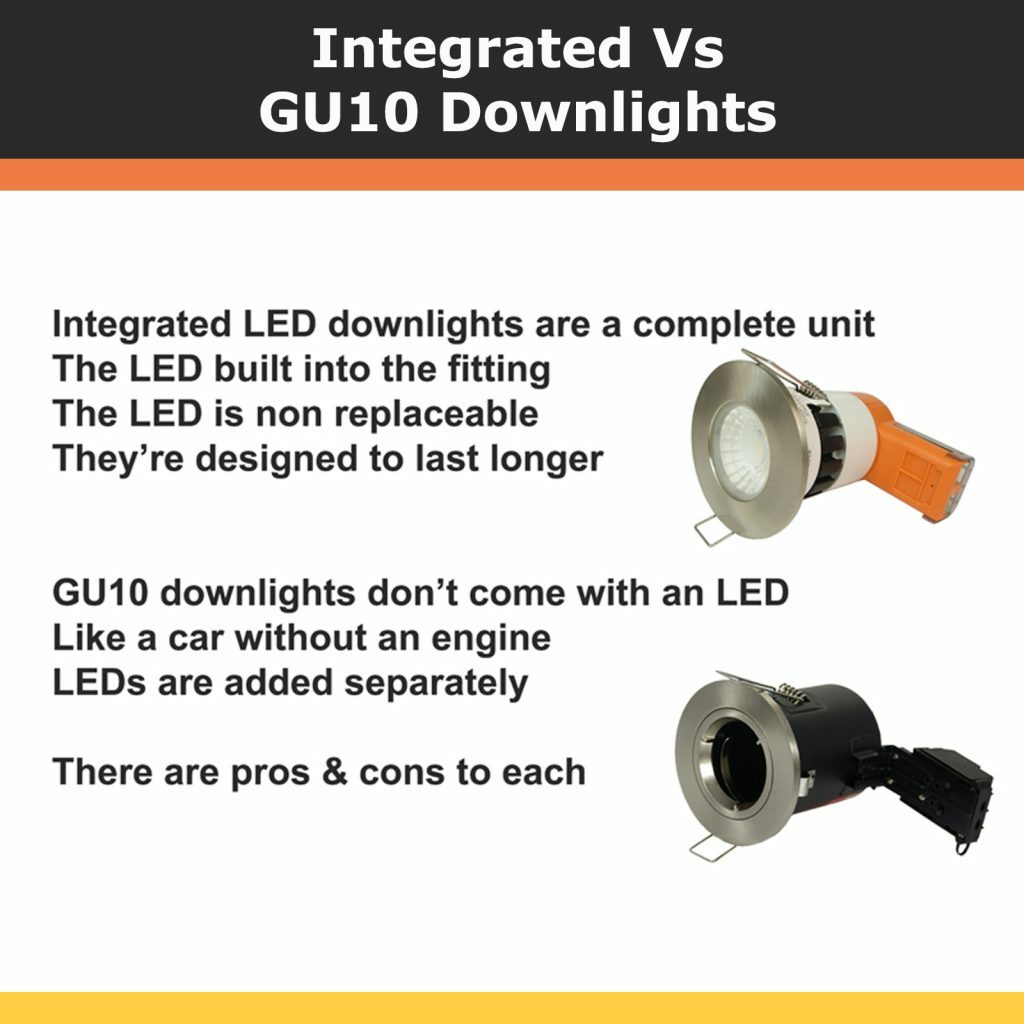The Truth About LED Downlights
Life at DownlightsDirect.co.uk started a few years before LED downlights even existed. The most popular choice of downlight was the now outlawed 50 watt halogen. During our tenure as an online lighting retailer, we’ve seen many different types of downlight come and go.
Main Types Within the Marketplace
To explain the truth, we must first compare the main types available within the marketplace. The two main types of LED downlight are integrated and GU10.


Integrated LED downlights are designed around the LED light source and are a light fitting known as a luminaire. Before the arrival of integrated LED downlights, they were made up of two separate components; the downlight housing and the lamp (also known as a light bulb).

What is an LED Downlight?
An LED downlight can be a completely integrated unit, or it can come in two parts. Ultimately, it's a low energy LED light source fitted inside a downlight housing.
Are LED Downlights as Reliable and Long Lasting as They Say?
Throughout our history, we’ve maintained our relationships with premium branded lighting manufacturers such as Aurora, Collingwood, JCC and Philips Lighting. Even these top-quality brands have had problematic versions of downlights.
The most consistent and reliable downlight of all-time is the Halers H2 Pro. This product was a game-changer for integrated LED technology. We’ve experienced the fewest failure rates with this product, its successfully outlasted its 7-year guarantee period and still remains a market leading product.
The least reliable downlights we’ve sold have been the Aurora I9 and possibly the JCC FGLED6. These particular downlights had a few ‘bad batches’ and unusually high failure rates. However, these brands have learned from their mistakes and gone on to develop more reliable products with the Aurora MPRO and JCC V50.
The truth about integrated LED downlights is that some models come and go quite quickly. This can be a problem if you get a failure and need to replace it. If your particular product has been discontinued then the latest version won't fully match the others.

On occasion, integrated downlights do fail and do need replacing but they are more reliable than the traditional GU10 LED and fire can combination which is the housing of the downlight structure shown in the image above.
If you buy downlights that don't have a wiring cable connector block you'll also have to disconnect them by rewiring them which will mean getting an electrician involved. If you've got downlights with proper plug-in wiring connectors shown below, you can easily disconnect them. Then you can usually reconnect the new one as it should have the same plug-in connector.

These connectors make integrated LED downlights work in a similar way to GU10. Instead of removing the lamp from the fitting, you're removing the fitting from the ceiling. No additional tools required!
What are the Best LED Downlights?
Integrated LED downlights with wiring connectors are considerably better. Collingwood and Aurora downlights are particularly good quality with an especially low failure rate. Integrated downlights have a more modern appearance and feature vastly advanced technology.
If you put a GU10 LED inside a traditional fire can downlight housing and have it on for long periods per day (3 hours+), you'll most likely discover they don't last for very many years and you'll be forever having to replace the LED. Overheating is the #1 cause of LED failure. If you're going to go for GU10, then choose a downlight with airflow like the Aurora EFD Pro, Ansell Edge or Integral EvoFire.
Integrated downlights feature advanced cooling capabilities. They have a dedicated heat sink that dissipates the heat more effectively, which helps to prevent heat from building up like it does inside a fire can.
I would judge the best LED downlights on reliability, so the award for best LED downlight goes to the Collingwood Lighting Halers H2 Pro 550T.

Thanks for reading, this post was produced by Chris Horridge, the UK's downlight connoisseur.


I have found the use of a wider angled LED lamp often with a slightly higher output solves this problem. The best one I have found recently is the Enlite ICE 240V GU10 5W 60D 480lm dimmable LED Lamp 2700K. This gives you a 60 degree dimmable GU10 lamp in warm white. I have numerous LED lamps in my house and no failures so far so I think the wide angle is a more important feature than the lamp life. I found these lamps available quite cheaply (£3.22) from downlights direct. They produced a dramatic improvement in our kitchen!
We also have an article about beam angles here
If you use an open rated GU10 downlight such as the Ansell iCage or Integral EvoFire, the GU10 LED will receive more airflow as they've ventilated allowing for the GU10 LED to last longer.
My main point is that integrated LED downlights are technologically more advanced but they're not perfect as they can fail, which is accurate.
Integrated downlights are available in most colour temperatures from 2700K to 4000K. Limited versions are available in the higher k values, or you could opt for CCT adjustable downlights which have them all in one.
Click Scolmore have been selling the FlameGuard GU10 downlights with a Click Flow connector for years and they make wiring much faster.
Thanks for interesting article about pros and cons of various Led lighting options.
While having plug type connectors is great what about some sort of retrofit system to stop damage to a cutout hole?
Maybe, there are some tools available to avoid this, but after few changes, damage gets extensive.
I wonder why down-lighters manufacturers don't design some other installation feature.
Like what, you might ask?
Something along the lines of install once collar and then screw in (or clip in) LED source.
Yes, something like a traditional bulb and bulb holder.
Most people would pay premium for easily replaceable fitting.
Andrew
PLEASE HELP!